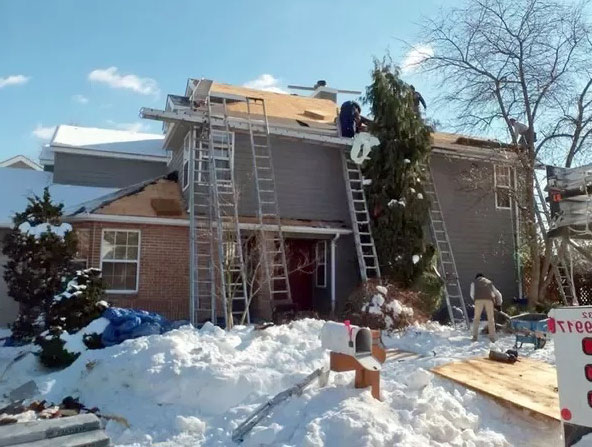Suppose you have shifted to your new home or need a roof replacement during the winter season. Now, you want to do roofing, or you’ve got someone to install your roof, but your roofing contractors never really worked in the cold season before. As a result, it begs the question, can roofing be done in winter?
Roofing is possible in winter, but it requires appropriate preparation, monitoring, and safety procedures. We do not consider cold conditions ideal for roof installation, especially in winter months, but sometimes it becomes necessary.
In this article, we will let you know every single detail in this aspect. Let’s start digging.
Can Roofing Be Done In Winter?
The harsh wind and temperatures of winter do not restrict roofing work. Even though it is not the most significant or most convenient season to do roofing, it has both benefits and drawbacks in winter.
So, before doing any roofing work during the cold-weather season, both homeowners and roofing professionals must consider both arguments.

Things to know
To do roofing work in winter, you must consider some facts. These are as follows:
Temperature in winter roofing
The main reason that roofing in the winter season is so difficult is the temperature. Suppose you want to use asphalt shingles in your roof in the cold season. In that case, you might notice that it is not correctly sticking to your top because the adhesive characteristics of the asphalt shingles do not work under 40 degrees Fahrenheit.
Even the Fiberglass shingles start to break at a lower temperature.
Installing Shingles
It’s recommended to keep the temperature above 40 degrees Fahrenheit to set the seal on the roof construction. It ensures sound shingle installation and prevents subsequent ice jams. During colder months, cracking and damage are more likely to occur. Moreover, temperatures may also fluctuate rapidly.
Installing Metal Roof
As the temperature drops below freezing, the adhesive characteristics of the shingles do not employ metal. The winter does not affect the product quality. The purpose of metal roofing is to prevent water from rising.
Sealing process in winter roofing
You cannot seal all roofs in temperatures below zero degrees Fahrenheit. In most cases, roofers wait for the ideal temperature to come before starting the sealing process. Temperatures around 70° Fahrenheit are suitable for sealing.
Manufacturer’s guide
In general, 40° Fahrenheit or above is acceptable for roofing. But some roofing materials need special treatment. That’s why you should read the manufacturer’s guide to find ways to overcome these obstacles when required.
Wear Proper Shoes
Roofs may become quite slippery in winter. To feel safe and have a firm grip on your roof, you’ll need shoes with traction soles that can grab the roof in a firm or secure manner. Soles made of rubber grips firmly on slippery and damp surfaces.
Advantages and Drawbacks
Like everything in this world, roofing in winter also has mixed blessings. Here are some advantages and drawbacks of roofing in winter.
Advantages of Roofing in Winter:
- Roofing in winter eradicates and slows down the progression of worsening structural problems.
- If the sealing process is done with the utmost effort, the heat supplied by the heating system will last longer.
- Due to proper roofing, there will be less damage to the equipment of lawns and gardens.
- As a result, the Homeowner can find peace knowing that they can hold up in hectic weather.
Drawbacks of Roofing in Winter:
- Cold weather makes asphalt shingles more fragile. That’s why if we use asphalt shingles for roofing in winter, then there is a risk that it will break.
- Moreover, when installing the valleys if the shingles are bent too far, it might crack. That means that water leakage might occur.
- Because of snowfall, the homeowner has some additional tasks as they may need to remove snow, ice from the roof first. Otherwise, the roof surface will become slippery, increasing safety risks, therefore slowing the overall progress.
Maintenance of Roofing in Winter
Even though your roof is not entirely replaced in winter, it might still need some servicing. For example, the shingles may break under your weight, especially if they’re on a rough surface or slightly curved.
Walking on them in winter can be dangerous. So, you should be ready to hand seal shingles that are breaking in your roof.
Conclusion
Now, you know, can roofing be done in winter or not. So, don’t be discouraged by the cold or snow while roofing. Despite having some drawbacks, roofing in winter has some benefits too.
Therefore, a successful roof installation in winter may be achieved by experienced roofing contractors if done carefully.





